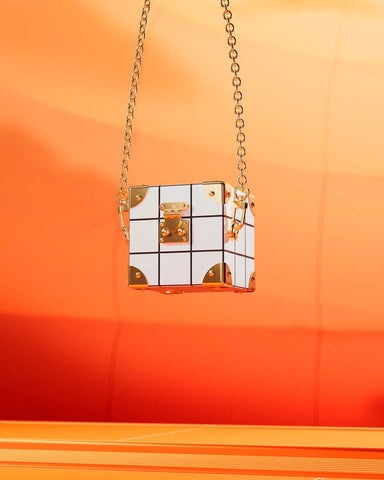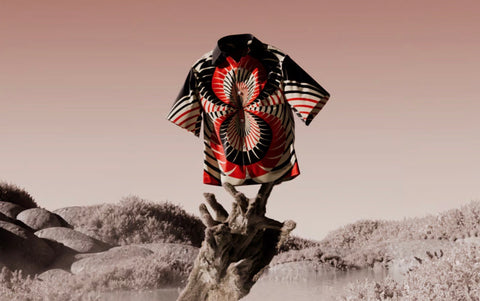New techniques have made the production of counterfeit handbags easier, making it even more difficult to identify imposters from the real deal. But with cutting edge innovations, luxury brands are fighting back with even more sophisticated technologies in the form of non-fungible tokens (NFTs) and blockchain technology. And what are they, I hear you ask? A quick lesson.
NFTs are simply digital files. They can be a jpeg of an artwork, video or handbag. They’re unique digital assets that are not fungible, meaning they’re not easily replaceable by another identical item. A $5 note on the other hand is fungible as it can be replaced with another $5 note. Turning files into NFTs helps secure them via blockchain. So what’s the blockchain? Essentially, it’s an online ledger that can’t be overwritten or hacked. It’s a shared, distributed and immutable ledger that facilitates the process of recording transactions, starting with transaction number one. And it's the technology that enables the existence of cryptocurrencies such as Bitcoin.

These tools are proving incredibly valuable and happily received by luxury brands in the endless battle against counterfeits. In fact, they may be just the tools the brands need to start winning the counterfeit war. Over the years, companies have tried many different strategies to stay ahead of the criminals: lobbying governments in order to extend enforcement bodies’ powers to seize and destroy fakes, and to prosecute buyers and dealers; blocking access to websites that sell the fake items; and employing armies of lawyers. LVMH alone employs more than 60 lawyers and spends around $20m annually on anti-counterfeiting legal action. But sadly, all this has little effect.
NFTs and blockchain technology could finally be the superpower these companies need, transforming the luxury industry. Indeed, many are saying NFTs are the future of the industry. Since NFTs make it possible to track the provenance of an item and track ownership, they can ensure that an item is genuine. The downside is the high cost and technical complexity required to implement these solutions. As a result, many luxury brands may need to partner with tech companies or add their own tech departments.

Above: VIA Tile Trunk by Nicolas Ghesquière. Image: @louisvuitton
The way the link between product, NFT and blockchain works is simple in theory. Each physical item can be paired with an NFT certificate on the blockchain, allowing for verification of the item’s legitimacy. To link the physical item to the NFT, typically a QR code or a near field communication (NFC) tag serves as the identifier on the physical asset. Whenever the token’s details are modified e.g. when it’s purchased or sold, the corresponding physical token will also be updated. This innovation not only redefines how counterfeits are tackled, but also restores faith in luxury brands.
Another way NFTs can help authenticate high-end products is by providing enhanced transparency in the supply chain. By tracking the movement of goods from production to delivery, NFTs can help to ensure that luxury products are ethically sourced and produced. This can help to build trust with consumers and ensure that luxury products are not associated with unethical practices such as child labour or environmental damage.
This new era has also opened up a world of other opportunities for brands and their customers to explore and enjoy. NFTs offer new ways for customers to engage with their brands. They can be used to create unique digital experiences, such as virtual showrooms, immersive product demonstrations, and interactive brand experiences.
Companies are also now creating digital fashion. Consumers can now buy pieces designed exclusively for the digital realm. Prada used NFTs to develop and auction off unique virtual clothes in digital fashion shows, upgrading the opulent shopping experience to an inventive digital realm and merging tradition with current technology for a one-of-a-kind consumer experience. When the brand launched its exclusive ‘Time capsule’ NFT collection – a series of shirts featuring prints by Italian photographer Enzo Ragazzini from his 60s and 70s archive, it was an instant hit. So successful that Prada recently announced a 3rd and final release of these NFT shirts.

Above: Prada Time Capsule NFT. Image: @Prada
Other retailers are minting NFT collectibles that hold sentimental value for buyers. Many fashion brands have released NFTs featuring iconic, unique or limited-edition copies of designs and collaborate with famous artists. Last year Louis Vuitton unveiled its first ever digital collectible. The released came in the form of a revamped version of the iconic Speedy 40 bag, designed in collaboration with Pharrell Williams. It was a limited-edition digital collectible but with an added benefit. In January this year, owners of the NFT had the opportunity to purchase a physical version of the bag.
So as we step into a future where technology continues to redefine industries, the marriage of NFTs and blockchain technology offers a beacon of hope for the luxury market. The authentication of luxury bags through this innovative approach not only safeguards the interests of consumers but also preserves the integrity and exclusivity that define the world of luxury. The dawn of NFTs and blockchain in luxury authentication signals a new era where trust, transparency, and technology converge to protect and enhance the value of the finest creations in the world of fashion. The future looks bright.
https://au.louisvuitton.com/eng-au/faq/products/digital-collectibles-au
https://www.prada.com/au/en/pradasphere/special-projects/2020/prada-timecapsule.html
